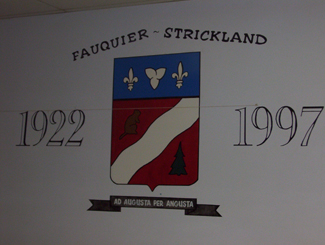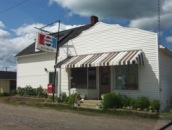
Given the number of crazy posts I had on the old Monteith page, I suspect that Monteith Correction Facility used to be a source of …”interesting” comments before I upgraded the comment system.
Monteith is about 20 kilometres northwest of Matheson (on Highway 11), and 11 kilometres south of Iroquois Falls. Most people see places like Monteith as dots-on-the-map, but if you look behind the map you’ll find that places like these often have some pretty neat histories.
Monteith was founded in 1916 as Driftwood City (the ‘city’ part obviously debatable to some ) but was destroyed by fire soon after. The town (‘town’ less debateable) was then rebuilt as the home of a demonstration farm. I’ve been told that the town was named Monteith after a former Provincial Minister of Agriculture.Val Gagné is a largely francophone hamlet of about 50 houses 30 minutes south of Iroquois Falls.
The demonstration farm was eventually converted into a military training centre, which was then used as a boarding school, which was then turned into an abandoned boarding school, which then turned into a jail, which then turned into a World War II Prisoner-of-War camp, which then turned back into a jail.
Today Monteith is known for being the home of Monteith Correctional Centre, a medium security prison that bears an eerie resemblance to my old high school. The facility is pictured here (Monteith, not my old highschool.)
Paul emailed in to tell me that during the summer of ’64 or ’65 there was an iron ore discovery north of Timmins. This was quite a rich find, and was followed by a huge smelter being built just outside of Timmins. The find of iron ore sparked speculators and claim staking in an area of approx. 40 – 50 miles all around Timmins. There were literally hundreds and hundreds of claims staked.
Apparently, a Toronto Star reporter with a vivid imagination described the exploration boom with the following headline: “Startled guards at the Monteith Correctional Centre discovered miners tunnelling underneath the jail in search of iron ore”. Of course it wasn’t true. Apparently somebody must have fed that reporter quite a line, but it was good for a few laughs. (I guess they didn’t check sources in those days).
I’ve only been to Monteith once, so I haven’t done a tonne of exploring. I counted maybe 20 houses (there are probably more, I always seem to under-count and get emails later) there is the Mary Magdalene Church (pictured), an old playground, a pop machine, and oddly enough a totally random garden centre. There;s probably more I just didn’t get to see it that day.
Val Gagné
Val Gagne isn’t directly on Highway 11 – it’s about a 10 minute drive east of the main highway. Val Gagné is one of many tiny little farming communities that typifies northern Temiskaming.
In town, Sunshine Café and Variety on rue Principale serves cold beer and also has an LCBO outlet. Last time I was there the store was for sale (I know a lot of people who would love to own their own liquor store, just maybe not in Val Gagné.) There are a few other businesses, including Guay’s Garage, a caisse, a foodmart, and of course, a church.
I took a photo of the old National Tavern as a tribute to the town’s past. I thought it was shut down and boarded up, but in fact I’ve been told that it’s still open.
Val Gagné apparently has one of the nicest baseball fields in all of Ontario and hosts an annual baseball tournament on the August long weekend named Val Gagné Days. There is also an annual corn roast that attracts 10 000 people from across the north. If you explore the cemetery there is a statue to be found commemorating the people who died in the Great Fire of 1916.
A former Val Gagné resident emailed me regarding the website and alerted me to the fact that I’m making their hometown (and many others) seem like a “ramshackle collection of abandoned huts”. While that’s definitely not the case, nor the intent (at least not on purpose) there may be more to the town than met my eye that rainy afternoon in August.
(Photo are “pour” to incessant rain.)
























